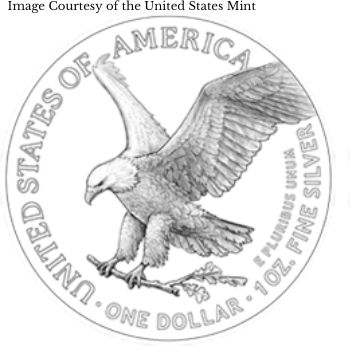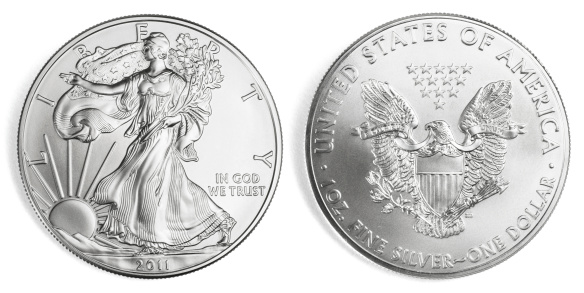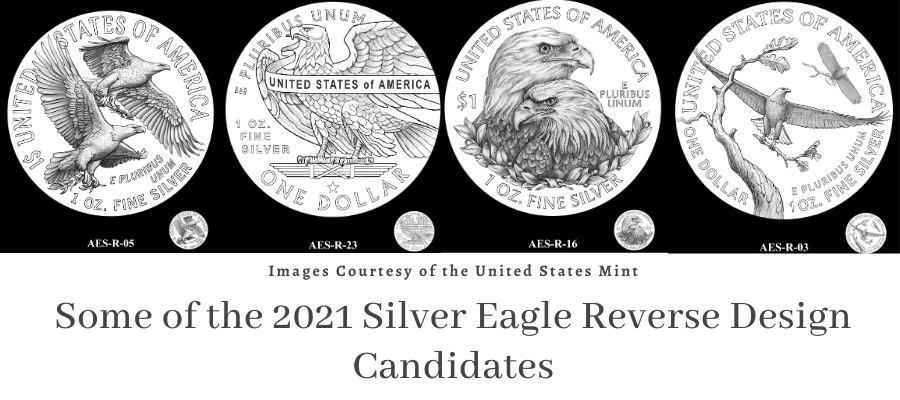Type 2 American Silver Eagles Coming Soon
Apr 2nd 2021
Type 2 American Silver Eagles Coming Soon
Last year the U.S. Mint announced that after using the same obverse and reverse designs on the American Silver Eagle since its debut in 1986, they would launch a new reverse design for this icon coin in 2021.
New reverse design

Dubbed the type 2 Silver Eagle, that new reverse was unveiled last October. It depicts an American Eagle carrying an oak branch as it prepares to land in a nest. Surrounding the eagle design are inscriptions for the country of issue, denomination, weight and fineness as well as the national motto, “ E Pluribus Unum”.
The motif was designed by Emily Damstra, a freelance natural science illustrator who has been part of the U.S. Mint’s Artistic Infusion Program for several years who has designed over 40 other U.S. coins and coins for the Royal Canadian Mint and postage stamps for the United Nations. The design was sculpted by Michael Gaudioso, who retired from the Mint last year as a Sculptor-Engraver.
Ms. Damstra noted of her design: “My inspiration for this design grew from a desire to show our national bird—with all of the values it embodies—in a unique way that could also convey traits such as diligence, cooperation, care, and protection.”
When this news about the new Silver Eagle broke, many collectors thought the 2020 American Silver Eagle would be the final coin to feature the reverse design used since the beginning, which is the Heraldic Eagle created by former U.S. Mint Chief Engraver John Mercanti, who designed more coins for the Mint than any other person.
But last fall the Mint also announced that this year, 2021 Silver Eagle coins of both type 1 and type 2 reverses would be issued, and that the type 2 coins would debut around June. There is still no firm release date yet.
So far, the Mint has issued bullion coins and Proof pieces minted at the West Point Mint with the original design. There are also the Philadelphia and San Francisco Mint Emergency Issue bullion coins.
Later it will issue these coins with the type 2 reverse: Proofs minted at West Point and San Francisco, the annual West Point burnished uncirculated coin, a special 2-coin Reverse Proof set that is expected to include coins with the new design and possibly others too.
Type 1 reverse history

According to the law that established the American Silver Eagle program, the Liberty Coin Act of 1985, the reverse of the coin must carry an image of an American Eagle. That design can be changed only after its has been used for 25 years based on a law from the 19th century, and once changed it can’t be changed again for another 25 years.
On the one hand, there has been growing interest among collectors for years in seeing new designs on this flagship coin, especially on the reverse since the obverse design by Adolph Weinmann based his Walking Liberty half dollar obverse -- that shows Lady Liberty striding towards the dawn of a new day -- remains extremely popular. There are not many collectors who want to see the obverse changed.
On the other hand, changing the design on such a major coin poses some risks, especially for those who are primarily bullion stackers and those who are partial to the original reverse design.
Mercanti’s original reverse remains popular with plenty of collectors. It was modeled after the Great Seal of the United States and shows an eagle spreading its wings behind a union shield that is clutching arrows as well as olive branches – the twin motifs used on many past coins to represent the message that the U.S. is prepared to defend itself but wants peace. 13 stars appear above the eagle, and in its beak, it grasps a ribbon with the motto, “E Pluribus Unum,” or “Out of many, one.”
When asked to create the reverse for this important coin, Mercanti first reviewed the countless eagles that has appeared on so many U.S. coins since the Mint’s founding. In fact, the earliest laws about the Mint required that an eagle appear on the reverse of every coin. He did not want to do what had been done before such as all those soaring eagles, flying eagles, etc. and wanted something that would be more formal and more heraldic, which is what led him towards his design.
After 35 years quite a few collectors and buyers are ready for something new. In addition, some feel the original reverse design is a bit static when paired with the dynamic obverse design.
But how was the new design selected?

Once the U.S. Mint’s Director David J. Ryder decided to pursue changing the reverse design, he had to receive approval by then Treasury Secretary Stephen Mnuchin, which he received in 2019. The Mint’s artists then prepared a large portfolio of 39 designs that include a wide range of classic and modern-looking motifs. They were reviewed last June by the Citizens Coinage Advisory Committee and the Commission on Fine Arts, which ended up picking different designs to recommend.
The CFA recommended the design that was eventually selected, while the CCAC initially coalesced around the same one but at the last minute recommended switching it with the design recommended for the Gold Eagle – a close-up profile of the head of an eagle that was ultimately selected by the Treasury Secretary for that coin. But the Secretary stuck with the design of an eagle landing for the silver coin – a more traditional design than the one that will appear on the gold coins.
The new reverse design is expected to inject a lot of excitement into the American Silver Eagle series, including bringing in plenty of new collectors who will want to build sets of the coins with both design types. This could help push values for some of the better date and key date coins up in the future since more people will be looking for those coins.
Finally, keep in mind that the new design also coincides with the introduction of increased security and anti-counterfeiting devices on the coin that are designed to bring them up to the higher security standards of coins like the Canadian Maple Leaf. This is being done in large part because of the increasing threat of fake coins.


